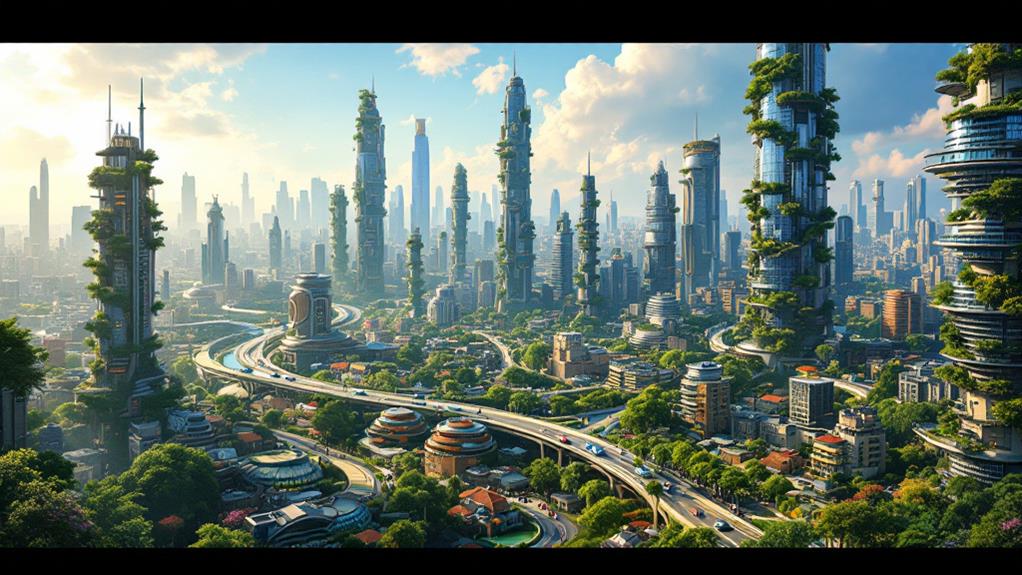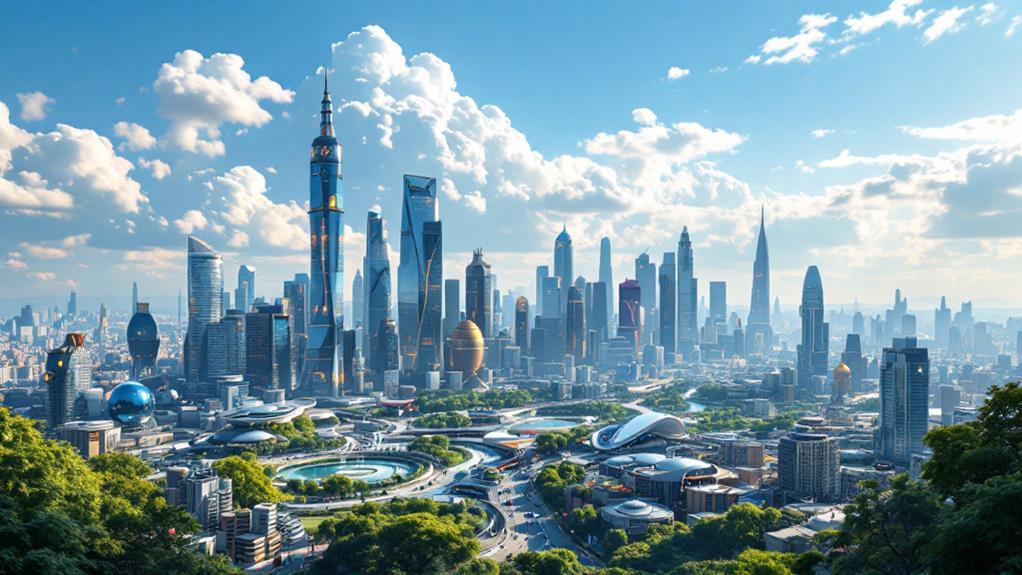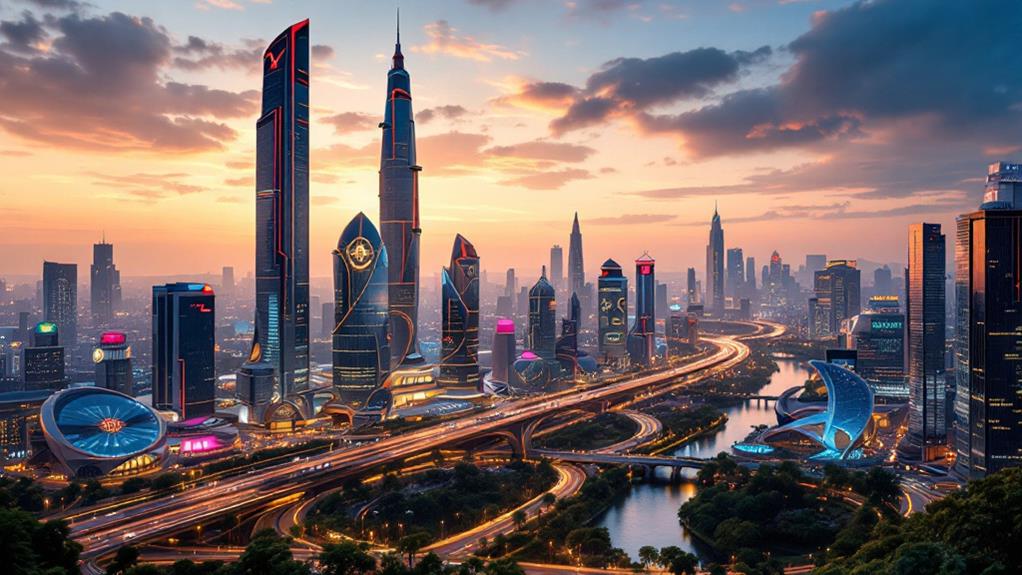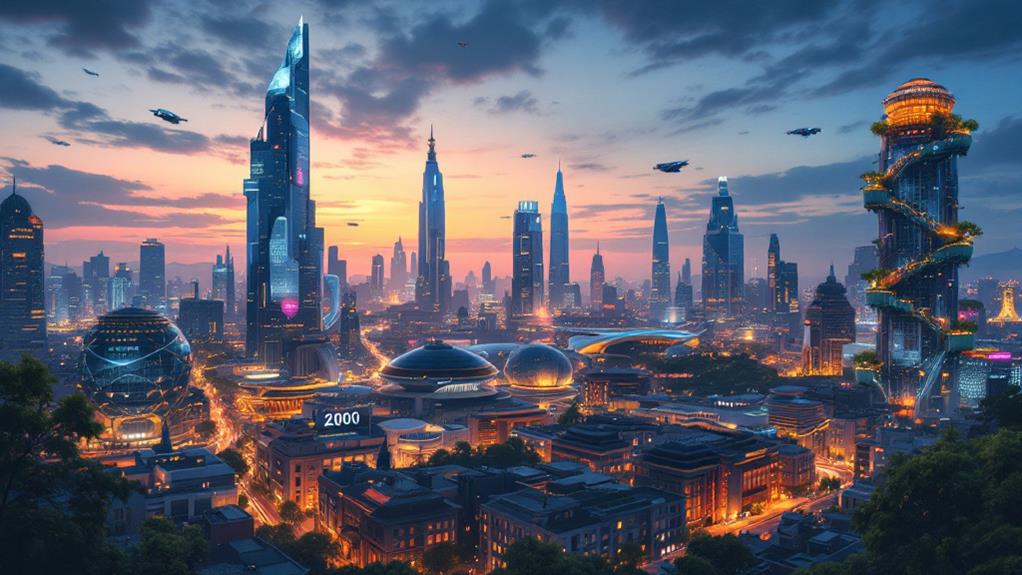The Future of the Largest Urban Areas: Predicting Urban Growth by 2050

By 2050, you'll find nearly 68% of the world's population living in urban areas. This growth adds 2.5 billion people to cities, mostly in developing regions like India, China, and Nigeria. Megacities will rise, with New Delhi, Shanghai, and others at the forefront. Urbanization will enhance global GDP, yet it also demands sustainable strategies to tackle housing, transportation, and environmental issues. Efficient infrastructure and adaptable policies are essential for supporting this transformation and ensuring equitable living conditions. Investigate how cities are planning for these challenges and the role of community engagement in shaping tomorrow's urban landscape.
Global Urbanization Trends
By 2050, we'll witness a profound transformation in urban landscapes worldwide. The urban population will soar, with 68% of the world population residing in cities, marking a significant rise from 55% in 2018. This global urban shift signifies an enhancement of 2.5 billion urban dwellers, driven primarily by urban growth in developing countries like India, China, and Nigeria. These nations alone will account for 35% of this surge, as economic activities increasingly concentrate in urban areas.
As the world adopts urbanization, megacities will become a dominant feature, with 43 anticipated by 2030, primarily in developing regions. High population density in these areas will necessitate creative urban planning strategies to create sustainable urban environments. Despite the rise of megacities, almost half of urban dwellers will still inhabit smaller settlements with populations under 500,000, highlighting diverse urban growth patterns.
With the rapid expansion of urban populations, sustainable urban development will be essential. Effective urban planning can alleviate challenges like overcrowding and resource management. As cities evolve, focusing on balancing economic activities with livability will be key to ensuring that urban areas remain lively and resilient hubs for the global urban populace.
Regional Urban Shifts
Urban landscapes are undergoing dramatic shifts, with Asia and Africa at the forefront of this transformation. By 2050, these regions are expected to account for 90% of the global urban population growth, adding a staggering 2.5 billion people to cities. India, China, and Nigeria are leading this charge, collectively contributing 35% of the world's urban growth. India will add 416 million urban residents, China 255 million, and Nigeria 189 million, underscoring the rapid urbanization in these developing regions.
In Asia, the urbanization rate is nearing 50%, reflecting a significant change from rural to urban living. Meanwhile, Africa's urbanization rate stands at 43%, showcasing its own movement towards urban centers. This development is not just about numbers but also about the emergence of megacities. As urban growth continues, you'll notice a trend towards increased centralization, with many countries seeing over half of their urban population concentrated in a single, dominant city. This phenomenon is particularly evident in parts of Africa and Latin America.
Understanding these regional urban shifts is vital as they shape the future of urban living in developing regions, highlighting both opportunities and challenges ahead.
Megacities on the Rise

As you investigate the evolving urban landscapes, the rise of megacities becomes a focal point of discussion. By 2050, the number of megacities is expected to swell to 43, primarily in developing regions. Asian countries, in particular, will lead this urban population growth. Currently, Tokyo holds the title of the largest city with 37 million residents, but its population is projected to decline. This shift opens opportunities for cities like New Delhi, which is anticipated to burgeon, reaching a significant 29 million, marking it as one of the fastest-growing megacities.
The concentration of urbanization in these massive hubs reveals a compelling narrative. Cities such as Shanghai, Mexico City, and São Paulo will maintain urban populations around 22 million, underscoring the dense clustering of global urban dwellers in a few major cities. Despite the expansion of these giants, nearly half of the urban population still resides in settlements under 500,000. This trend indicates that while megacities are on the rise, smaller urban areas continue to play a essential role in the broader urbanization picture. Understanding these dynamics is imperative as you investigate the future of urban growth and its implications.
Challenges in Urban Planning
With the world's urban areas projected to accommodate a supplementary 2.5 billion people by 2050, the challenges in urban planning become increasingly urgent and complex. You face an intimidating task: managing rapid urbanization while ensuring sustainable infrastructure and services. Population growth in urban areas, particularly in Asia and Africa, demands significant improvements in healthcare, education, and sanitation. Without careful planning, these challenges can exacerbate existing inequalities, making it difficult for everyone to access crucial services.
Inadequate housing and transportation systems are pressing issues, especially in regions like India, China, and Nigeria, which are expected to contribute to 35% of global urban growth. You must develop tailored strategies to address these unique challenges. As cities expand, sustainable planning becomes critical to manage environmental impacts. Currently, urban areas account for two-thirds of global energy consumption and over 70% of greenhouse gas emissions. Implementing eco-friendly solutions can help mitigate these effects.
The need for resilient infrastructure is paramount. By focusing on sustainable practices, you can create urban environments that support both population growth and environmental health. Efficient urban planning is the key to transforming these challenges into opportunities for sustainable urbanization.
Economic Implications of Growth

Cities' burgeoning populations by 2050 will transform them into economic powerhouses, generating over 80% of global GDP. This wave of urbanization means cities will spearhead economic development as urban populations swell. You're looking at a world where developing countries experience urban growth at rates 2.5 times higher than their developed counterparts, prompting a necessity for tailored economic strategies. These strategies must address:
- Infrastructure investment: With 2.5 billion people moving into cities, a $5 billion annual investment is essential for infrastructure and services.
- Sustainability: Cities will consume two-thirds of global energy and emit over 70% of greenhouse gases, urging a balance between growth and sustainability.
- Economic shifts: Urbanization will lead to higher living standards and a change from agricultural to industrial and service employment.
To harness this economic potential, you must focus on sustainable infrastructure that supports urban populations without exacerbating energy consumption and greenhouse gas emissions. Crafting economic strategies that promote such growth while considering environmental impacts is key to thriving in this new urban period. As cities evolve, so too must the policies that govern them, ensuring both economic dynamism and ecological responsibility.
Sustainable Development Strategies
Increasingly, sustainable urban development is a cornerstone for accommodating the projected influx of 2.5 billion people into cities by 2050. As urban growth accelerates, integrated policies become significant in addressing the housing, transportation, and infrastructure needs of burgeoning urban areas. You can't underestimate the importance of these strategies in shaping livable, equitable urban environments.
Urban areas are responsible for over 70% of global greenhouse gas emissions, so adopting low-carbon strategies is fundamental to mitigate climate change impacts. It's imperative to focus on urban planning that incorporates green spaces and energy-efficient systems to reduce emissions. The World Bank's $5 billion annual investment in urban projects highlights the significance of enhancing city planning systems and building local capacities for sustainable growth.
Moreover, inclusive urban policies that prioritize marginalized communities play a crucial role in bolstering city resilience. These policies guarantee equitable access to critical services, helping communities withstand economic and environmental shocks. Coordinated efforts like the City Resilience Program mobilize capital for climate and disaster resilience projects. As rapid urbanization continues, you'll find that addressing climate vulnerabilities through sustainable development strategies is key to fostering resilient, thriving urban environments.
Future Urban Projections

Looking ahead, it's clear that future urban growth will reshape our cities dramatically. By 2050, the urban population is expected to swell by 2.5 billion, with cities housing two-thirds of the world's people. India, China, and Nigeria are set to play crucial roles, contributing greatly to this projected growth. Collectively, they will add 416 million, 255 million, and 189 million urban dwellers, respectively, accounting for 35% of global urban expansion. This surge will see the emergence of approximately 43 megacities by 2030, primarily in developing regions across Asia and Africa.
Such rapid urbanization necessitates careful and sustainable urban planning. Urban land consumption is forecasted to outpace urban population growth by 50%, highlighting the urgent need for strategic development. Urban areas will not only expand in size but also in economic importance. By mid-century, they are projected to generate over 80% of the global GDP, underscoring their essential role in economic development.
To grasp the magnitude of these changes, consider:
- Urban population: Two-thirds of the global population living in cities
- Megacities: 43 by 2030, mainly in developing regions
- Global GDP: 80% generated by urban areas
These projections demand forward-thinking strategies to guarantee sustainable and equitable urban futures.



